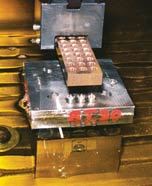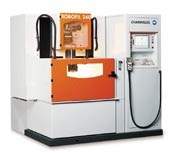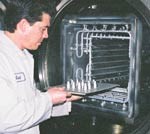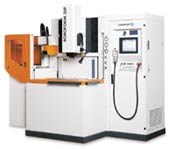Process Pioneers
There is something different about the molds this shop builds. This puts EDM in a whole new light. These molds are not designed to produce plastic parts, like the typical injection mold. Rather, these molds produce parts in metals such as stainless steel and other alloys.
Using electrical discharge machining (EDM) to make molds is nothing new. In fact, sinking cavities in mold blocks is one of the earliest applications of EDM. This is one of the main reasons why we speak of “sinker” machines to refer to the kind using an electrode that descends into the workpiece, eroding away material with microscopic high-voltage discharges of electrical energy.
Ryer Industries, LLC, of Temecula, California, uses a ram EDM unit to produce detailed cavities in the molds it builds for the metal injection molding (MIM) process. But—as Tom Shappie, Ryer’s director of operations, admits—the company isn’t really doing anything extraordinary when it comes to using EDM to make molds. “We’re pretty much like any expert mold shop sinking cavities with the EDM process,” he says.
However, there is something different about the molds Ryer Industries builds. This puts EDM in a whole new light. These molds are not designed to produce plastic parts, like the typical injection mold. Rather, these molds produce parts in metals such as stainless steel and other alloys. This capability creates many interesting possibilities. In fact, Ryer Industries was founded to research various techniques for using the MIM process as an alternative to other methods of manufacturing. Some of these techniques directly benefit EDM. For example, MIM allows the company to produce moldable materials with promising properties for use as EDM electrodes, which would make EDM faster and more efficient.
Ryer Industries is also using wire EDM in MIM applications. Wire EDM uses an energized wire to slice through metal along a programmed path as the wire feeds from a supply spool like an endless, super-fine band saw. Wire EDM helps the company create low-cost prototypes of parts that eventually will be produced in expensive permanent molds.
Among the moldable materials that Ryer Industries is developing are several special grades of tungsten carbide that can only be produced by the MIM process. These carbide grades are superior for certain types of tooling components, some of which have lasted up to 30 times longer than their conventionally produced counterparts. These outstanding wear characteristics prompted the company to look for ways to improve wear parts on the EDM equipment it relies on. Current projects in this effort involve parts for wire EDMs.
At Ryer Industries, EDM helps MIM and MIM helps EDM.
Like Baking A Cake
Baking a cake is a matter of mixing together several ingredients, putting the mix into a pan, and then putting the pan in a hot oven. By changing the ingredients or their proportions, a good cook can bake cakes of many flavors and textures.
The MIM process is somewhat similar.
As Bob Sanford, president of Ryer Industries, explains, the MIM process starts with very fine, spherically-shaped metal particles. These particles are mixed with various thermoplastic binders and processed into a pelletized form, called feedstock. This feedstock is supplied to injection molding machines very much like the injection molding machines used in the plastics industry. In the molding machine, the feedstock is heated to a temperature that melts the binder but not the metal particles. In this slurry state, the feedstock can be injected under pressure into a mold and allowed to cure. When the binders set up, the molded part is released from the mold as a “green” part.
According to Mr. Sanford, a subsequent debinding process removes most of the binder, leaving what is known as a “brown” part. Next, the brown part is sintered in an atmosphere-controlled furnace, first at a lower temperature to remove any residual binders, and then at a higher temperature to fuse the metal powders together to form a fully dense solid similar to a wrought metal workpiece. Parts shrink considerably during sintering—as much as 25 percent, so the mold must be oversized. The shrinkage, however, is predictable in all dimensions, and once the mold and the molding, debinding and sintering profiles have been zeroed in, the entire process is very consistent and repeatable. Close tolerances can be maintained. The sintered parts can be machined, plated, buffed, polished and even heat treated.
Just as a cook can follow different recipes to make chocolate, angel food or pound cake, engineers can follow different formulations to produce moldable materials for the MIM process. In some cases, combining different metals together as a mix of powders allows engineers to create alloys with properties unlike or superior to alloys produced in a steel mill or foundry. MIM can produce parts in soft magnetic materials, low alloy steels, stainless steel, and other metals.
Equally important, molding these materials allows engineers to produce complex, intricate shapes that are very close to finished form, requiring fewer secondary operations or none at all, says Mr. Sanford.
Bringing In EDM
The molds for metal injection are somewhat different from plastic injection molds. According to Mr. Shappie, one of the key differences is in the gates and runners of a metal injection mold. These critical features must be designed to suit the way the melted feedstock flows, which is unlike the flow of molten plastic.
The actual construction of the molds, however, follows typical mold-building practices. By using core pulls and slides, metal injection molds can produce complex shapes with cross holes, undercuts and other special features.
Originally, Ryer Industries relied on a number of outside mold shops to supply components for its metal injection molds. As the company’s business grew, however, the volume of mold work increased to the point that it could justify strengthening its in-house mold production capabilities.
In May of 2002, the company acquired its first EDM equipment, taking delivery of both a ram and a wire machine from GFAGIECHilles Technologies (Lincolnshire, Illinois). The ram, or “sinker” unit, is a Roboform 35P, a mid-sized CNC machine featuring a drop tank design. It is one of the builder’s latest generations of ram machines. The wire unit, a Robofil 240, is also one the builder’s newest mid-sized models. It features submerged cutting and other advanced features.
Both EDMs are used to construct molds for metal injection molding. Ryer Industries produces two classes of molds. One class is the production tooling designed to mold a customer’s “green” part. The other class consists of molds for producing simple shapes that can be machined into prototypes for testing.
Rapid Prototyping
One of Ryer Industries’ specialties is the production of carbide forming and punching tools. These products include forming dies for cold heading and hot heading equipment used in the fastener industry, as well as punch pins for high-precision, long-run punching dies. The MIM process offers several advantages in the manufacturing of this carbide tooling, says Mr. Sanford.
For one, Ryer Industries has developed tungsten carbide feedstocks that yield sintered workpieces with outstanding wear qualities. These formulations are proprietary, but Mr. Sanford attributes the performance characteristics to the highly homogenous blend of metal particles attainable in the feedstock. Another advantage lies in molding the tools to produce shapes that, when fully sintered, need few secondary operations to complete. Some of these shapes would be difficult or impossible to machine from conventional carbide blanks.
Prototypes allow the customer to test one tungsten carbide grade against another, or against conventionally made tungsten carbide. These tests not only prove the superiority of this tooling material versus other carbides or HSS, but they also optimize the selection of the MIMed carbide grade. The tests also determine how much shrinkage will occur during sintering. Knowing this shrinkage factor allows the permanent mold to be designed with the appropriate oversize dimensions to compensate.
It would be too costly and time-consuming to produce these prototypes in permanent molds, so Ryer Industries machines them from metal injection molded blanks. One blanking mold can be used to produce blanks from any number of different feedstock formulations. These blanks will have identical material characteristics as a punch or die produced in the permanent production mold.
The molds for producing blanks are rather simple, and their construction is straightforward. However, both ram and wire EDM are used to machine the blanks into shapes matching the finished parts.
The tungsten carbide Ryer Industries has developed for the fastener industry is extremely tough to machine. Even using EDM, which is noted for its ability to machine hard materials, is challenging. Carbide is difficult to EDM because the process can leach the cobalt binder from the surface, leaving it vulnerable to microcracking.
For this reason, Ryer Industries relies on the Hard Metal Kit that is part of the power supply on the Roboform 35P. This optional feature is designed especially for EDMing hard metals such as carbide. Essentially, special circuitry in the power supply enables it to monitor and adjust sparking parameters at very high speed. Near perfect control of the spark prevents the conditions that degrade the integrity of the carbide surface without lengthening the “burn” times or experiencing excessive wear of the electrode, with resulting loss of geometric accuracy.
Production Tooling
The permanent molds used for production involve more complex geometries and a tighter tolerance than the molds for producing blanks. One such mold that Ryer built recently was a multi-cavity family tool that produced two different parts for the same assembly. The first part was a Y-shape valve that featured three slide pulls that required wire EDM to manufacture. The other part was a vented box that was produced using matching slide faces. The slide geometry was formed with ram EDM using electrodes produced on CNC mills.
The company’s mold shop is well equipped for machining electrodes. Typically the manufacturing engineers will evaluate which method is best to produce the finished product. If EDM is chosen, they will design electrodes to be manufactured. Depending on the shape, quantity and other factors, electrodes will either be CNC milled or wire cut with EDM. Sometimes both processes are used in combination. When milling electrodes, Ryer uses a pallet system that ties together the CNC mill and Roboform 35P. When wire cutting electrodes, the shop uses a custom-designed workholding system and ground blanks to maintain accuracy. Emphasis is placed on electrode fabrication because high quality electrodes produce high quality parts.
Improving Ram EDM
Because the cost of production molds for metal injection molding is a major factor in the economies associated with the MIM process, Ryer Industries is constantly looking for greater efficiencies in the mold-building operations, especially those involving EDM. One of the most promising projects currently under development is a new electrode material based on the MIM process itself.
Because the company “knows tungsten” as Mr. Sanford would say, it was natural for Ryer Industries to explore tungsten alloys with possible application as EDM electrodes. Copper tungsten, which has been used as an electrode material for several decades, was an obvious starting point.
Conventionally, copper tungsten is formed by infiltrating a pure tungsten billet with pure copper in a furnace. Unfortunately, the finished material is not entirely uniform in its metallurgy. The copper does not always disperse uniformly throughout the tungsten, making it unpredictable as an electrode because spark conditions vary according to the surface copper content. Copper tungsten is also more difficult to machine than other electrode materials.
The MIM process suggests solutions to both difficulties. Because MIM feedstocks can be thoroughly blended as a mixture of particles, they yield highly uniform and homogenous grain structures after debinding, with the copper and tungsten uniformly distributed. This uniformity promotes stable EDM performance. Likewise, because the material can be molded into complex shapes, the need for substantial milling, turning or grinding can be reduced. What’s more, the material’s uniform conductivity lends itself to wire cutting with EDM.
Currently, Ryer Industries is testing various formulations of its copper tungsten feedstock. Mr. Sanford expects that copper tungsten electrodes produced by MIM will exhibit faster material removal and require lower power settings. The benefits include reduced EDM time and better surface finish while retaining the superior geometric accuracy associated with the low wear of a tungsten-based electrode.
Improving Wire EDM
Given Ryer Industries’ interest in EDM and its expertise in wear-resistant tooling materials, it is no surprise that the company would turn its attention to the development of wear parts for wire EDM.
For example, Ryer Industries is working with GFAGIECHilles Technologies to develop sets of upper and lower power contacts injection molded from Ryer’s tungsten carbide. Power contacts transmit electrical energy to the EDM wire as it passes across the contacts. As with the majority of its development projects, Ryer is machining the prototype power contacts from blanks.
Ryer uses its Robofil 240 wire EDM to cut the contacts from various grades of its MIMed tungsten carbide blanks. Ryer has already determined internally that these power contacts are showing significantly longer life with brass EDM wire. Once the optimum grade of tungsten carbide has been identified, Ryer will fabricate a multi-cavity production mold to mass produce these improved power contacts, which will be available for new and existing GFAGIECHilles wire EDMs.
A similar story can be told about blades for wire cutters (also known as choppers or chopper cutters), which play a very functional yet hardly glamorous role in the EDM process. Because EDM wire cannot be reused (the surface of the wire undergoes thermal, chemical and physical changes during EDM), it must be disposed of. Most wire machines can be equipped with wire cutters that cut the spent wire into short lengths for deposit in a large capacity bin.
Although cutting the wire is not a precision operation, reliable performance of the wire cutter is one more aspect of unattended operation that cannot be overlooked. Used EDM wire tends to be hardened and brittle, so the wire cutter will wear and need replacement. For the same reasons that metal injection molded tungsten carbide is highly suitable for power contacts, it is highly suitable for wire cutters as well.
More EDM To Come
Since its development in the late 1980s, the MIM process has been growing in importance as an economical alternative to conventional manufacturing processes. Mr. Sanford expects this growth to continue as more and more design engineers recognize its potential for reducing lead times, eliminating steps and achieving superior workpiece properties. “We’re extending the boundaries for the process by developing new feedstock materials and by pioneering methods to make bigger, longer and more wear resistant parts with MIM,” he says. “We expect our need for additional EDM capacity to grow along with new MIM applications.”
Not only will more EDM be needed for applications the company has in place already, but new uses for it will be discovered along the way also. “EDM is like that, we’ve learned,” says Mr. Sanford. “Both MIM and EDM have untapped potential for revolutionizing how parts are made.”
Related Content
When Organic Growth in Your Machine Shop Isn’t Enough
Princeton Tool wanted to expand its portfolio, increase its West Coast presence, and become a stronger overall supplier. To accomplish all three goals at once, acquiring another machine shop became its best option.
Read MoreGrinding Wheel Safety: Respect The Maximum Speed
One potential source of serious injury in grinding comes from an oversight that is easy to make: operating the wheel in an over-speed condition.
Read MoreThreading On A Lathe
The right choices in tooling and technique can optimize the thread turning process.
Read MoreBuying a Lathe: The Basics
Lathes represent some of the oldest machining technology, but it’s still helpful to remember the basics when considering the purchase of a new turning machine.
Read MoreRead Next
3 Mistakes That Cause CNC Programs to Fail
Despite enhancements to manufacturing technology, there are still issues today that can cause programs to fail. These failures can cause lost time, scrapped parts, damaged machines and even injured operators.
Read MoreThe Cut Scene: The Finer Details of Large-Format Machining
Small details and features can have an outsized impact on large parts, such as Barbco’s collapsible utility drill head.
Read More













.png;maxWidth=300;quality=90)




















